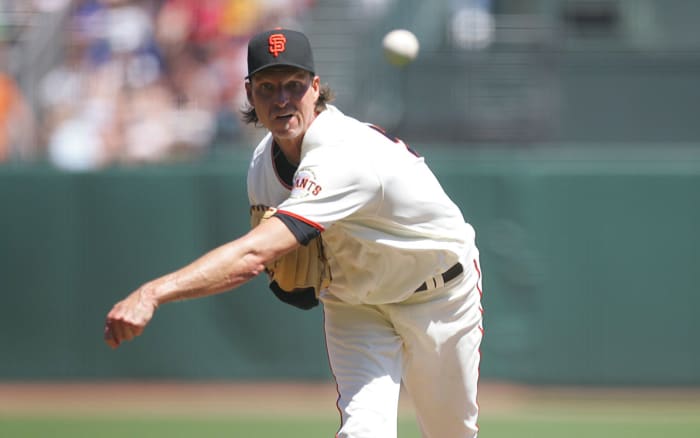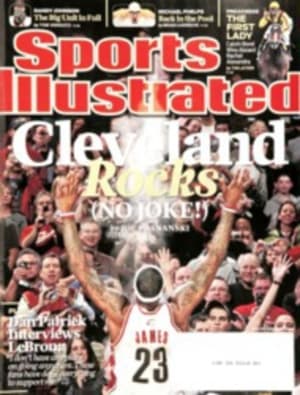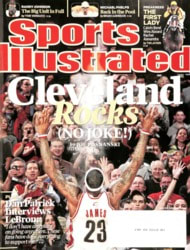Randy Johnson Will Grind Your Bones To Make His Bread
At the height of his prowess, Randy Johnson threw 102 miles an hour slingshot-style and wore a Deadwood mustache, a mud flap of a mullet, and a scowl atop his 6'10" frame that had the don't-mess effect of an armed prison guard high in a turret. He threw with such ferocity that a tooth filling once dislodged clear from his tightly clenched jaw and out of his mouth. He once virtually vaporized an unfortunate dove in mid-flight, a puff of feathers the residue of Johnson's fastball. No pitcher ever scared left-handed hitters out of the lineup and sent them scurrying, like mice to their holes, the way he did. Rumor had it he would grind their bones to make his bread.
"He was just an intimidating presence," says former Mariner Dan Wilson, who was on the receiving end of more of Johnson's games (109) than any other catcher. "I went to the mound once to talk to him. I could tell something was wrong. I said, 'Randy, what's the problem?' He said, 'My hair keeps whipping into my eyes.' I said, 'Get a haircut,' but I didn't think he would do that. It would take away from his persona."
So dominant was Johnson that before a game in 1993, the home plate umpire told Mariners catcher Dave Valle, "They don't even need you with Randy pitching."
"What are you talking about?" replied Valle, who would not name the ump.
"He's so good they don't need you. Let me call the pitches tonight."
"I let him call every pitch." recalls Valle, to whom the umpire whispered pitches under his breath.
An overpowering Johnson went the distance in a Mariners victory.
When he was traded from the first of his six clubs, the Montreal Expos, in 1989, a notoriously wild Johnson had just three career wins at age 25. By his 30th birthday he had only 64 victories (fewer than, say, Jason Marquis had at the same age). He has overcome three back surgeries and endured a right knee without cartilage. Those who doubted him unwittingly provided the rebar for the construction of a remarkable career.
In 2005, with 251 wins but pushing 42, Johnson listened on the Yankees' bench as teammate Al Leiter told him that Tom Glavine might be the last 300-game winner.
"I looked at him and went, 'Oh, really?'" Johnson says. "The thought may have been in the back of my head, but I wouldn't be confident enough to say to anyone,'I'm going to do it.'"
Asked what makes him proudest about his career, Johnson replies, "Longevity. Battling adversity. Battling several knee surgeries. Battling two back surgeries late in my career as a power pitcher. That's like Buddy Rich, the greatest drummer of all time, having broken fingers or a broken wrist and wondering if things will ever be the same."
Now 45, and pitching for the San Francisco Giants, 45 miles from where he grew up in Livermore, Randall David (Big Unit) Johnson still casts an enormous shadow,notwithstanding his struggles this season (a 3–4 record, with a 6.86 ERA). He has pitched 22 seasons, struck out 4,831 batters and thrown 66,727 pitches. He needs just two more victories to reach 300 wins, the ultimate pitching imprimatur. Not only would Johnson be just the 24th pitcher to reach that mark,but he also would be the tallest, quite possibly the last, and a very convincing case for the least likely. His career represents a feat of pitching engineering on a monstrous scale, the Hoover Dam of pitching projects. The arc of this massive undertaking can be traced through his milepost victories.
Win No. 1 THE THROWER
Johnson was an oddity, not a potential 300-game winner, when he made his debut for the Expos on Sept. 15, 1988. He beat the Pittsburgh Pirates 9--4 while throwing 93 pitches in five innings. In that garish Montreal cap, blond locks spilling out like an overturned bowl of linguine, he looked more amusing than menacing, not unlike when he was a minor leaguer and had to contort himself into the backseat of his old, beat-up VW Beetle—the front seat had been removed—in order to drive. "I remember being the most nervous I had ever been," Johnson says of that first game. "I remember Glenn Wilson hit two home runs off mein that game. And I go, 'Wow. Who is this guy?' I didn't know players back then."
Johnson made four starts for the Expos that month and won three of them. He made the big league club the next spring but was sent back to Triple A after starting the season 0–4 with 26 walks in 29 2/3 innings. Montreal traded him to Seattle that May to acquire left-handed ace Mark Langston.
"I had velocity and that's what I got by on at that time," Johnson says. "You see it all the time with young pitchers. You can throw 97, 98 and throw it down the middle, and for the most part you can get away with it. I was blessed with velocity. You really can't teach that. So absolutely, I was a thrower in the beginning, and then over time I developed the ingredients of location and movement to be more of a pitcher."
No. 50 THE STUDENT
On Opening Day of the 1993 season, Johnson threw 120 pitches, struck out 14 batters and, with Valle, not the umpire, calling pitches this time, beat Jack Morris and the defending world champion Blue Jays 8--1. Johnson was evolving, and Valle could sense—well, literally feel—the change. Valle used to wake up with a sore left shoulder the morning after catching Johnson, who was so wild that he would regularly throw fast balls extremely high and away to righthanders, forcing his catcher to reach across his body to stab at the ball. The force from those pitches would tug on the muscles of Valle's left shoulder.
One day in 1992 at the Kingdome in Seattle, Texas Rangers pitching coach Tom House, who, like Johnson, had attended USC, said to the Unit, "Hey, do you want to watch Nolan [Ryan] throw a bullpen [session]?" Johnson said yes, and he wound up getting a pitching lesson from House and Ryan, both of whom detected a flaw in his delivery.
"I was landing on the heel of my foot instead of the ball of my foot," Johnson says."When I would land on the heel of my foot I would spin, my arm would dropdown, I would fall toward third base. That was the one thing I did consistently. I was consistently wild."
Johnson made an adjustment, and success followed almost immediately. Later that year, when matched up against Ryan, he struck out 18 batters in eight innings, throwing 160 pitches. His pitching had started to turn a corner.
That winter, his father, Bud, passed away, "so I took what I learned from Nolan and a heavy heart into the '93 season," says Johnson, who would go 19–8 and strike out 308 batters that year. "That was really the defining moment, because I felt like I would dig down a little deeper from that point on, and I would throw more pitches if I had to, to throw more innings, to get us closer to winning the game."
"He was coming into his own as a player and a person," Valle says. "I told him once,'Randy, I wish you could face yourself as a hitter. If you stood in the box against yourself, you'd see you're one of the baddest men on the planet.'Nobody wanted to face him."
No. 100 THE INJURED
"Once you let Randy get two or three innings of scoreless baseball, your team was in trouble," says Dan Wilson, who caught No. 100, an 8–5 Mariners win over Milwaukee on April 6, 1996. "He got stronger as the game went on. He could outlast you. He could throw 120 pitches and number 120 would be just as hard as number 1."
Johnson's victory over the Brewers, however, was the second of four starts to begin that season in which he threw 129, 122, 123 and 128 pitches—this after a year in which he had gone 19--2 and pitched six times in the season's final 20 days, playoffs included. By the end of May, Johnson's back finally gave out and he needed surgery.
From 1990 through '95, Johnson threw 150 pitches or more in a game eight times; all other major league pitchers combined had 23 such games during that period. "All that stress goes somewhere," Johnson says, "and evidently it went to my back. I've never had any arm problems."
Nos. 150 and 200 THE LEGEND
After a deadline deal to Houston in 1998, Johnson went 10–1 with the Astros and led them to the playoffs, setting him up for a four-year, $53 million free-agent contract with Arizona at age 35. Over the next four years, Johnson won 81 games (including wins 150 and 200), lost 27, struck out 1,417 batters in 1,030 innings, and won four Cy Young Awards, four strikeout titles, three ERA titles and a world championship. The final year of that run, '02, which Johnson identifies as his best, he won pitching's triple crown (24 wins, 334 strikeouts, 2.32 ERA) while turning 39. "You can compare the four years I had to anybody's in baseball," Johnson says, "to anybody's in any sport."
Johnson's extraordinary four-year run occurred in the last four seasons before baseball began testing for steroids. Johnson never has been tied directly to performance-enhancing drugs. Convicted steroids dealer Kirk Radomski, however,wrote in his book Bases Loaded that investigators for the '07 Mitchell Report asked him if he knew about steroid use by Johnson, Curt Schilling, Gary Sheffield, Ivan Rodriguez or Alex Rodriguez. Radomski wrote that he had no knowledge of steroids use by those players. (Only Sheffield was named in the report.)
Johnson says that in those years he hired a professor from Canada to educate him on nutrition and training. He says that he used a hyper baric chamber to improve recovery time and "dabbled in all kinds of powders and tried to put weight on." When asked what would have stopped him from using steroids at a time when baseball did not specifically ban them, Johnson pauses, then says, "Because I wasn't searching for anything other than to have the ability to throw the ball over the plate. You can do your homework. I've always thrown as hard as anybody in the game. There's no denying that. I've [also] always been skinny. I'm not denying that I went to GNC and all that stuff. I took a lot of different things that, you know, maybe at that time, maybe early enough, if I would have been tested, who knows? I could have been taking stuff had they tested me back then.Maybe I would have tested [positive for a banned supplement]. I don't know."
Johnson is asked if he could assure his fans that his achievements have been legitimate, because even clean players can be wrongly suspected. "You've got to [ask] what you've got to [ask], I guess," Johnson says, before adding, "How long have we been doing drug tests now?"
Told testing began with anonymous survey tests in 2003, he replies, "Okay, what's that? Six years now? I'm 45 ... 39 to the present and I've passed every test and I've still had some pretty good years."
No. 250 THE TWILIGHT
Johnson won his 250th game, a 6–4 win over Oakland on May 15, 2005, in his eighth start after being traded to the Yankees before that season. It was one of only seven career starts in which he failed to strike out a batter. Johnson did win 34 games in two seasons in New York, but he pitched through back problems in what were two of the least dominating seasons of his career.
"It was challenging," Yankees catcher Jorge Posada says of handling Johnson."He was tough to talk to. Not when it came to pitching and catching and calling his game. It was just getting to sit down and go to a friend. That was the toughest thing. Because you didn't know how he was going to be that day."
Says Johnson,"I felt kind of beat up a little physically there. All the intangibles: the amount of innings, the weather, the new environment, pitching against all the teams I had to pitch against.... There was no relief. You'd be pitching against Boston and have to face them five days later."
The New York years made Johnson consider how much longer he would be able to pitch. "I will tell you, it started creeping into my head," he says, "at age 41, 42.Pitching in New York has a way of having things creep into your head that otherwise wouldn't be there. Nobody needs to tell me when I'm not pitching well. But it's reinforced that you're not."
No. 300 LAST CALL
Johnson has not decided whether to retire after this season, saying, "I take one game at a time. They've got me going for 300. I'm only at 298. I don't look that far ahead."
Johnson frequently counsels young San Francisco pitchers such as 2008 Cy Young Award winner Tim Lincecum and lefthander Jonathan Sanchez. "I told Lincecum that I won a Cy Young in '95, '99, 2000 and 2001," Johnson says. "I already had four Cy Youngs. I could have been content. But it wasn't until 2002 that I had my best year statistically. I feel like I've never been content."
Lincecum has 28 career wins and turns 25 in June. He would have to average 15 wins a year until he's 43 to reach 300 career wins. After the Unit, Philadelphia's Jamie Moyer is the active leader with 249 career wins, but at 46 he's even older than Johnson.Toronto's Roy Halladay would need to average 16 wins a year through age 42—another 11 years. The White Sox' Mark Buehrle would need 15 wins a year for another 12 years, when he'll be 41. So, yes, it's possible another 300-game winner is already on his way, but it's unlikely, and the degree of difficulty may grow greater as starting pitchers pitch fewer innings and qualify for fewer wins.
Then again, hasn't the prolific and persistent career of Johnson taught us anything about baseball's actuarial tables? Johnson has won more games in his 40s (70) than he did in his 20s (64). There may be another 300-game winner out there. It could be even longer, however, before we see another outsized character—mulleted or not—quite like Johnson.
"Fame comes in a moment," Valle says, "but greatness comes with longevity. And you've got to put him up there with the greatest of all time."
Johnson's story is pitching engineering on a huge scale, the Hoover Dam of pitching projects.
Asked what makes him proudest about his career, he says, "Longevity."
Arc of a 300-Game Winner
[1] The Little Unit, here at age 12, grew up in the BayArea. [2] Under USC coach Rod Dedeaux (center) and alongside Trojan teammateMark McGwire, Johnson tried out for (but did not make) the '84 U.S. nationalteam. [3] Poor mechanics made for a slow start in Montreal. [4] Johnson brokeout in Seattle, but still marched to the beat of a different drum. [5] In '98he forced a trade to the Astros. [6] He brought a title to Arizona in '01. [7]He encountered injury and controversy in New York.
Now on SI.com
Joe Posnanski weighs in on the Big Unit's place inhistory at SI.com/bonus
PHOTO
Photograph
by TIM
DEFRISCO
TALL TALE Nearly 80% of Johnson's victories have come since he turned 30, when he added command to his stunning velocity.
PHOTO
BRAD
MANGIN
 STILLSCARY Despite his struggles this season, the Big Unit remains a menacingpresence on the mound, with a strikeout rate that's still better than one perinning.
PHOTO
(2) COURTESY
USCPHOTO(3) RONALD C. MODRAPHOTO(4) V.J. LOVEROPHOTO(5) DAVID J. PHILLIP/APPHOTO(6) JOHN BIEVERPHOTO(7) WCBS-TV/APPHOTOREX BROWN/WIREIMAGE.COM/GETTY IMAGESTOWERING PEAK A remarkable stretch in pitching history included a co-MVP with Schilling in the 2001 Series and a perfect game against the Braves in '04 (top).PHOTOJEFF TOPPING/REUTERS[See caption above]PHOTO


